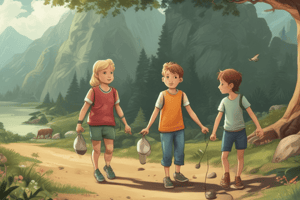Podcast
Questions and Answers
Which term describes the emotional bond between siblings that can often result in competition?
Which term describes the emotional bond between siblings that can often result in competition?
- Sibling resemblance
- Sibling rivalry (correct)
- Maternal instinct
- Close-knit relationship
What term refers to the impact of parental behaviors and environment on a child's emotional and social development?
What term refers to the impact of parental behaviors and environment on a child's emotional and social development?
- Character inheritance
- Parental instigation
- Nurture (correct)
- Temperament
Which of the following terms relates to the psychological bond that mothers traditionally exhibit towards their children?
Which of the following terms relates to the psychological bond that mothers traditionally exhibit towards their children?
- Maternal instinct (correct)
- Paternal instinct
- Sibling connection
- Familial resemblance
What can be described as a significant shared experience that fosters deeper connections among family members?
What can be described as a significant shared experience that fosters deeper connections among family members?
What term refers to the characteristics passed down from one generation to the next affecting family relationships?
What term refers to the characteristics passed down from one generation to the next affecting family relationships?
In what kind of family setup are children's relationships often more enriched due to the influence of multiple familial figures?
In what kind of family setup are children's relationships often more enriched due to the influence of multiple familial figures?
Which concept relates to the idea of emotional support and interconnectedness that stems from shared familial ties?
Which concept relates to the idea of emotional support and interconnectedness that stems from shared familial ties?
What term is used to describe the collective influence of both maternal and paternal roles in family dynamics?
What term is used to describe the collective influence of both maternal and paternal roles in family dynamics?
Which of the following phrases represents the concept of how shared experiences shape the relationships within a family?
Which of the following phrases represents the concept of how shared experiences shape the relationships within a family?
Which term best exemplifies the stable and nurturing environment provided by family to encourage healthy emotional development?
Which term best exemplifies the stable and nurturing environment provided by family to encourage healthy emotional development?
What concept refers to the phenomenon that can emerge from similarities between family members, often observed in familial features?
What concept refers to the phenomenon that can emerge from similarities between family members, often observed in familial features?
What term refers to the various psychological traits and behaviors that are inherited from one generation to the next within families?
What term refers to the various psychological traits and behaviors that are inherited from one generation to the next within families?
What term is used to describe the familial ties and connections that can enhance the emotional support system among relatives?
What term is used to describe the familial ties and connections that can enhance the emotional support system among relatives?
Which term best describes the various responsibilities that individuals may proactively take on within a family structure?
Which term best describes the various responsibilities that individuals may proactively take on within a family structure?
What term encompasses the essence of emotional bonds formed during shared life experiences among family members?
What term encompasses the essence of emotional bonds formed during shared life experiences among family members?
Which concept best illustrates the process by which family relationships can form and evolve over time?
Which concept best illustrates the process by which family relationships can form and evolve over time?
Which term refers to the situation when familial relationships weaken or fail due to unresolved issues or lack of communication?
Which term refers to the situation when familial relationships weaken or fail due to unresolved issues or lack of communication?
Which concept represents the interplay of emotional bonds and interactions among close family members?
Which concept represents the interplay of emotional bonds and interactions among close family members?
Which term best captures the idea of enduring ties that continue to evolve in a family over time?
Which term best captures the idea of enduring ties that continue to evolve in a family over time?
What term reflects the dual influence of biological connections and social roles in familial structures?
What term reflects the dual influence of biological connections and social roles in familial structures?
Flashcards are hidden until you start studying
Study Notes
Stages of Life
- Adolescence marks the transition from childhood to adulthood, characterized by physical, emotional, and social changes.
- Adulthood is typically associated with independence, maturity, and the ability to take on responsibilities.
Family Dynamics
- Bonds represent the emotional connections shared between family members, often strengthened through shared experiences.
- Brotherhood and sibling relationships can foster both friendship and rivalry, influencing personal development.
- Maternal and paternal instincts play crucial roles in nurturing and guiding offspring.
Key Relationships
- Friends provide support and companionship, contributing positively to emotional well-being.
- Strong family ties often lead to a close-knit environment, enhancing overall stability and security.
Character Development
- Upbringing significantly shapes an individual's personality and temperament, impacting future relationships.
- Interactions within families help develop social skills and resilience, preparing individuals for external conflicts.
Rivalry and Resemblance
- Sibling rivalry can emerge from competition for parental attention, influencing sibling relationships and dynamics.
- Striking resemblance among relatives can foster connections but may also lead to expectations based on family traits.
Parenting and Relationships
- Parenthood involves a rewarding yet challenging role, requiring adaptability and understanding.
- Extended family networks can provide additional support systems during upbringing.
Social Interactions
- Developing connections with peers is essential during teenage years, helping shape identity.
- Relationships often involve shared interests, contributing to the sense of belonging and community.
Personal Growth
- Individuals are urged to develop stable relationships through nurturing and open communication.
- Establishing a connection with others can lead to enriched life experiences and resilience against hardships.
Stages of Life
- Adolescence marks the transition from childhood to adulthood, characterized by physical, emotional, and social changes.
- Adulthood is typically associated with independence, maturity, and the ability to take on responsibilities.
Family Dynamics
- Bonds represent the emotional connections shared between family members, often strengthened through shared experiences.
- Brotherhood and sibling relationships can foster both friendship and rivalry, influencing personal development.
- Maternal and paternal instincts play crucial roles in nurturing and guiding offspring.
Key Relationships
- Friends provide support and companionship, contributing positively to emotional well-being.
- Strong family ties often lead to a close-knit environment, enhancing overall stability and security.
Character Development
- Upbringing significantly shapes an individual's personality and temperament, impacting future relationships.
- Interactions within families help develop social skills and resilience, preparing individuals for external conflicts.
Rivalry and Resemblance
- Sibling rivalry can emerge from competition for parental attention, influencing sibling relationships and dynamics.
- Striking resemblance among relatives can foster connections but may also lead to expectations based on family traits.
Parenting and Relationships
- Parenthood involves a rewarding yet challenging role, requiring adaptability and understanding.
- Extended family networks can provide additional support systems during upbringing.
Social Interactions
- Developing connections with peers is essential during teenage years, helping shape identity.
- Relationships often involve shared interests, contributing to the sense of belonging and community.
Personal Growth
- Individuals are urged to develop stable relationships through nurturing and open communication.
- Establishing a connection with others can lead to enriched life experiences and resilience against hardships.
Stages of Life
- Adolescence marks the transition from childhood to adulthood, characterized by physical, emotional, and social changes.
- Adulthood is typically associated with independence, maturity, and the ability to take on responsibilities.
Family Dynamics
- Bonds represent the emotional connections shared between family members, often strengthened through shared experiences.
- Brotherhood and sibling relationships can foster both friendship and rivalry, influencing personal development.
- Maternal and paternal instincts play crucial roles in nurturing and guiding offspring.
Key Relationships
- Friends provide support and companionship, contributing positively to emotional well-being.
- Strong family ties often lead to a close-knit environment, enhancing overall stability and security.
Character Development
- Upbringing significantly shapes an individual's personality and temperament, impacting future relationships.
- Interactions within families help develop social skills and resilience, preparing individuals for external conflicts.
Rivalry and Resemblance
- Sibling rivalry can emerge from competition for parental attention, influencing sibling relationships and dynamics.
- Striking resemblance among relatives can foster connections but may also lead to expectations based on family traits.
Parenting and Relationships
- Parenthood involves a rewarding yet challenging role, requiring adaptability and understanding.
- Extended family networks can provide additional support systems during upbringing.
Social Interactions
- Developing connections with peers is essential during teenage years, helping shape identity.
- Relationships often involve shared interests, contributing to the sense of belonging and community.
Personal Growth
- Individuals are urged to develop stable relationships through nurturing and open communication.
- Establishing a connection with others can lead to enriched life experiences and resilience against hardships.
Stages of Life
- Adolescence marks the transition from childhood to adulthood, characterized by physical, emotional, and social changes.
- Adulthood is typically associated with independence, maturity, and the ability to take on responsibilities.
Family Dynamics
- Bonds represent the emotional connections shared between family members, often strengthened through shared experiences.
- Brotherhood and sibling relationships can foster both friendship and rivalry, influencing personal development.
- Maternal and paternal instincts play crucial roles in nurturing and guiding offspring.
Key Relationships
- Friends provide support and companionship, contributing positively to emotional well-being.
- Strong family ties often lead to a close-knit environment, enhancing overall stability and security.
Character Development
- Upbringing significantly shapes an individual's personality and temperament, impacting future relationships.
- Interactions within families help develop social skills and resilience, preparing individuals for external conflicts.
Rivalry and Resemblance
- Sibling rivalry can emerge from competition for parental attention, influencing sibling relationships and dynamics.
- Striking resemblance among relatives can foster connections but may also lead to expectations based on family traits.
Parenting and Relationships
- Parenthood involves a rewarding yet challenging role, requiring adaptability and understanding.
- Extended family networks can provide additional support systems during upbringing.
Social Interactions
- Developing connections with peers is essential during teenage years, helping shape identity.
- Relationships often involve shared interests, contributing to the sense of belonging and community.
Personal Growth
- Individuals are urged to develop stable relationships through nurturing and open communication.
- Establishing a connection with others can lead to enriched life experiences and resilience against hardships.
Stages of Life
- Adolescence involves the transition from childhood to adulthood, marked by physical, emotional, and social changes.
- Adulthood is characterized by maturity, independence, and responsibilities, often including career development and family life.
- Childhood serves as a foundational phase for personality and social skills development.
Family Dynamics
- Brotherhood signifies the bond between brothers, often associated with camaraderie, rivalry, and support.
- Parent refers to caregivers who play a crucial role in nurturing and guiding children.
- Sibling relationships can encompass rivalry, connection, and lifelong companionship.
- Immediate family consists of parents and siblings, providing essential social support and ties.
Human Relationships
- Friendship involves mutual respect and support, enhancing emotional well-being.
- Connection refers to the emotional bond formed between individuals, essential for healthy relationships.
- Relationship encompasses various interpersonal dynamics, including romantic, familial, and platonic connections.
Emotional and Social Aspects
- Conflict arises in relationships and can lead to growth or breakdown, necessitating resolution strategies.
- Rivalry often occurs among siblings or peers, driving competition and personal development.
- Ties represent connections between individuals, influencing emotional and social stability.
Parental Roles
- Fatherhood plays a key role in a child's development, impacting social and emotional growth.
- Motherhood emphasizes nurturing and caregiving, essential for emotional security.
- Parental involvement and responsibilities shape a child's identity and life choices.
Development and Interaction
- Instinct influences behaviors and reactions, impacting relationships and socialization.
- Interaction is vital for developing communication skills and emotional intelligence.
- Developing stable relationships is crucial for personal growth and resilience.
Character and Nature
- Character reflects an individual's moral values and behavior, shaped by upbringing and experiences.
- Nature versus nurture debates highlight the influence of genetics and environment on personality and behavior.
Adoption and Change
- Adopt signifies accepting someone into a family unit, offering new opportunities for belonging.
- Establishing strong relationships requires effort and commitment to nurture connections.
- Break down of relationships can lead to significant emotional challenges but can also facilitate growth.
Role of Family and Relationships
- Active role in relationships emphasizes initiative and participation in fostering connections.
- Striking resemblance can indicate genetic ties, enhancing familial bonds and shared identity.
- Accommodate within relationships involves adjusting behaviors to meet each other's needs, promoting harmony.
Conclusion
- Rewarding relationships contribute to life satisfaction and emotional health.
- Stable family structures offer support and security, essential for personal development.
- Relate (to) emphasizes understanding and empathy in relationships, enhancing communication and connection.
Stages of Life and Relationships
- Adolescence is a critical developmental stage marked by physical, emotional, and social changes.
- Adulthood signifies maturity, characterized by independence, responsibility, and personal identity.
- Brotherhood emphasizes the bond between male siblings, often embodying shared experiences and loyalty.
Family Dynamics
- Character refers to the set of traits and behaviors that define an individual; it can be influenced by upbringing and relationships.
- Childhood is foundational; it shapes identity, values, and interpersonal skills through experiences and interactions.
- Conflict often arises in family settings, rooted in differing opinions, needs, or power dynamics.
Bonds and Connections
- Connection refers to the emotional ties between individuals, crucial for psychological well-being and support.
- Fatherhood entails the responsibilities and experiences associated with being a father, influencing both the parent and child.
- Friendship is formed through mutual affection, trust, and shared interests, contributing to social development and support systems.
Emotional and Social Foundations
- Instinct plays a role in guiding behavior, particularly regarding survival and relationship formation.
- Interaction is key in building and maintaining relationships, influencing social skills and emotional intelligence.
- Motherhood represents the nurturing role of a mother, with profound impacts on child development and family dynamics.
Nature and Nurture
- Nature refers to biological factors influencing personality and behaviors, while nurture encompasses environmental influences.
- The concept of a parent includes all caregivers; their roles significantly shape development and relationships.
- Relation and relationship are terms used to describe the connections among family members and friends, affecting social structures.
Family Structure and Rivalry
- Relative indicates family members who may or may not live together but share lineage.
- Rivalry often exists among siblings, typically stemming from competition for parental attention and resources.
- Sibling relationships can be complex, involving both competition and collaboration, influencing emotional health.
Developmental Concepts
- Teenagers experience unique challenges during adolescence, navigating identity and independence.
- Immediate family refers to close relatives, usually parents and siblings, providing the primary support network.
- Striking resemblance highlights genetic similarities among family members, often evident in physical attributes.
Parental Roles and Responsibilities
- Maternal and parental responsibilities encompass emotional support, guidance, and education for children.
- Rewarding experiences in parenting foster strong familial bonds and contribute to personal fulfillment.
- Stable environments promote healthy development, resilience, and long-term emotional well-being.
Adaptability and Growth
- Accommodate reflects the ability to adjust to new circumstances and the needs of family members.
- Adopt signifies the legal and emotional processes of becoming a parent to a child not biologically related.
- Endure relates to the capacity to withstand challenges within family relationships, fostering strength and resilience.
Establishing Connections
- Establish practices and traditions that strengthen family bonds and create lasting memories.
- Interact regularly to build rapport and understanding within relationships, fostering closeness.
- Play a role in the lives of others, influencing their growth and perspectives through positive engagement.
Relating to Others
- Relate to individuals by finding common ground, enhancing empathy and understanding in interactions.
Studying That Suits You
Use AI to generate personalized quizzes and flashcards to suit your learning preferences.




